#ancient nautiloid fossil
Explore tagged Tumblr posts
Photo

Cenoceras Fossil Nautilus - Beacon Limestone, Jurassic, Ilminster Somerset UK - Genuine Specimen with Certificate
This listing features a remarkable Cenoceras fossil nautilus, discovered on 18 April 2025 by our skilled fossil hunters Alister and Alison at Ilminster, Somerset, United Kingdom. The fossil has been meticulously cleaned, prepped, and treated by Alison, highlighting its coiled chambered shell and fine natural detail.
Cenoceras is an extinct genus of nautiloids that lived during the Jurassic period, particularly within the Beacon Limestone Formation. These ancient marine cephalopods are relatives of the modern nautilus, characterised by their planispiral shell structure with smooth whorls and internal chamber divisions that aided in buoyancy control.
The specimen you see in the photos is the exact fossil you will receive, photographed with a 1cm scale cube for reference.
Geological & Fossil Context:
Species: Cenoceras sp. (Nautilus)
Type: Fossilised marine cephalopod
Formation: Beacon Limestone
Location: Ilminster, Somerset, United Kingdom
Age: Jurassic (~201–174 million years ago)
Fossil Features:
Preservation: Outstanding, with defined whorls and chamber patterns
Preparation: Expertly cleaned and stabilised by Alison
Condition: Excellent; ideal for collectors, educational use, or scientific study
Product Highlights:
100% Genuine Fossil Nautilus
Discovered and prepared by Alister & Alison
Includes a Certificate of Authenticity
A striking specimen for fossil collectors and palaeontology enthusiasts
The Beacon Limestone of Ilminster is a renowned Jurassic fossil site celebrated for yielding exceptionally preserved marine life. This Cenoceras fossil nautilus is an exquisite representation of ancient ocean biodiversity and a must-have for any serious fossil collection.
Please refer to the listing photographs for sizing and condition. The item shown is the exact specimen you will receive.
Own a genuine piece of Jurassic marine history with this elegant Cenoceras nautilus fossil from Somerset.
#Cenoceras fossil nautilus#Jurassic nautilus fossil#Beacon Limestone fossil#Ilminster Somerset fossil#fossil nautiloid UK#fossil with certificate#genuine Jurassic fossil#fossil discovered by Alister and Alison#nautilus fossil cleaned by Alison#UK fossil specimen#fossil marine cephalopod#spiral fossil shell#ancient nautiloid fossil#fossil collector item
1 note
·
View note
Text

The distinctive pinhole eyes, leathery hood, and numerous tentacles of modern nautiluses were traditionally thought to represent the "primitive" ancestral state of early shelled cephalopods – but genetic studies have found that that nautiluses actually secondarily lost the genes for building lensed eyes, and their embryological development shows the initial formation of ten arm buds (similar to those of coeloids) with their hood appearing to be created via fusing some of the many tentacles that form later.
There's a Cretaceous nautilidan fossil that preserves soft tissue impressions of what appear to be pinhole eyes and possibly a remnant of a hood, so we know these modern-style nautilus features were well-established by the late Mesozoic. But for much more ancient Paleozoic members of the lineage… we can potentially get more speculative.
So, here's an example reconstructed with un-nautilus-like soft parts.
Solenochilus springeri was a nautilidan that lived during the Late Carboniferous, around 320 million years ago, in shallow tropical marine waters covering what is now Arkansas, USA.
Up to about 20cm in diameter, (~8"), its shell featured long sideways spines which may have served as a defense against predators – or possibly as a display feature since they only developed upon reaching maturity.
———
NixIllustration.com | Tumblr | Patreon
References:
Anthony, Franz. "500 million years of cephalopod fossils" Earth Archives, 19 Feb. 2018, https://eartharchives.org/articles/500-million-years-of-cephalopod-fossils/index.html
Klug, Christian, et al. "Preservation of nautilid soft parts inside and outside the conch interpreted as central nervous system, eyes, and renal concrements from the Lebanese Cenomanian." Swiss Journal of Palaeontology 140 (2021): 1-11. https://doi.org/10.1186/s13358-021-00229-9
Korn, Dieter, and Christian Klug. "Early Carboniferous coiled nautiloids from the Anti-Atlas (Morocco)." European Journal of Taxonomy 885 (2023): 156-194. https://doi.org/10.5852/ejt.2023.885.2199
Kröger, Björn, Jakob Vinther, and Dirk Fuchs. "Cephalopod origin and evolution: a congruent picture emerging from fossils, development and molecules: extant cephalopods are younger than previously realised and were under major selection to become agile, shell‐less predators." BioEssays 33.8 (2011): 602-613. https://doi.org/10.1002/bies.201100001
Mikesh, David L., and Brian F. Glenister. "Solenochilus Springeri (White & St. John, 1868) from the Pennsylvanian of Southern Iowa." Proceedings of the Iowa Academy of Science. Vol. 73. No. 1. 1966. https://scholarworks.uni.edu/pias/vol73/iss1/39/
Shchedukhin, A. Yu. "New Species of the Genus Acanthonautilus (Solenochilidae, Nautilida) from the Early Permian Shakhtau Reef (Cis-Urals)." Paleontological Journal 58.5 (2024): 506-515. https://www.researchgate.net/publication/384922837_New_Species_of_the_Genus_Acanthonautilus_Solenochilidae_Nautilida_from_the_Early_Permian_Shakhtau_Reef_Cis-Urals
Wikipedia contributors. “Nautilida” Wikipedia, 26 Nov. 2024, https://en.wikipedia.org/wiki/Nautilida
Wikipedia contributors. “Solenochilus” Wikipedia, 28 Apr. 2022, https://en.wikipedia.org/wiki/Solenochilus
#science illustration#paleontology#paleoart#palaeoblr#solenochilus#solenochilidae#nautilida#nautiloid#cephalopod#mollusc#invertebrate#art#doing the inverse of all those ammonite reconstructions that make them look like nautiluses
220 notes
·
View notes
Text
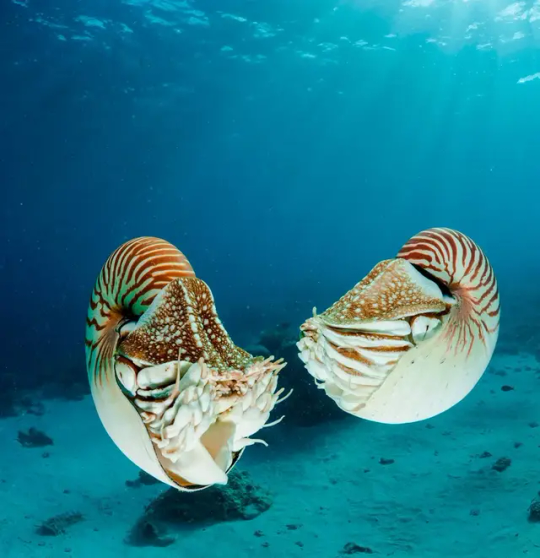

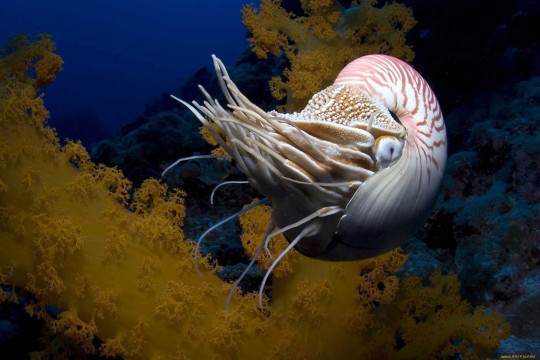
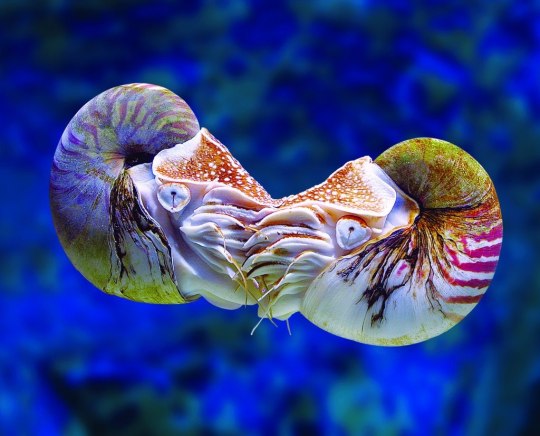
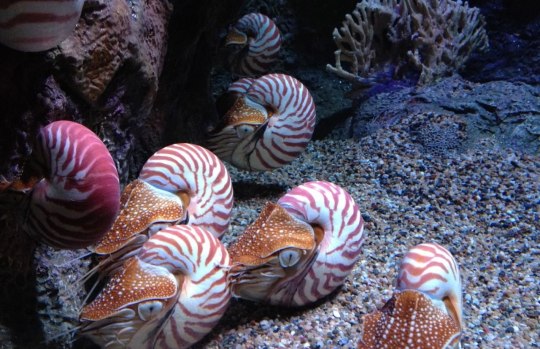
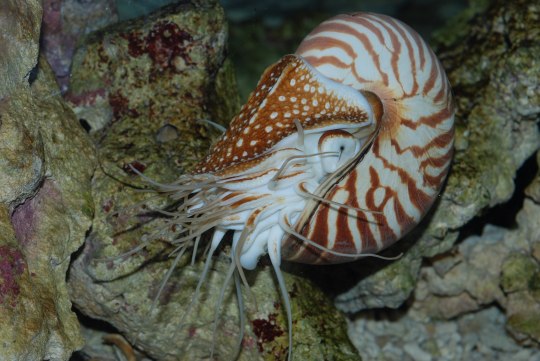
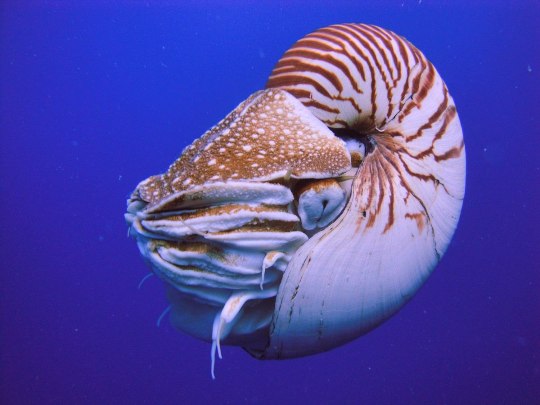
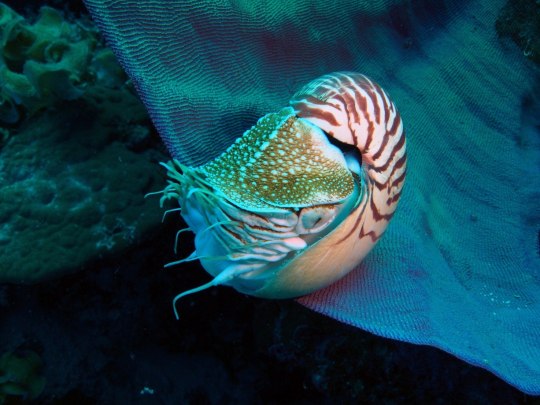




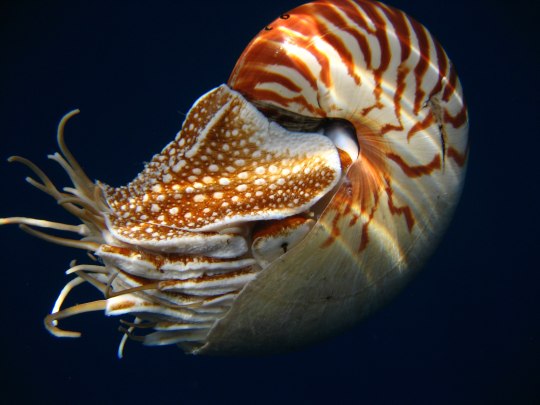
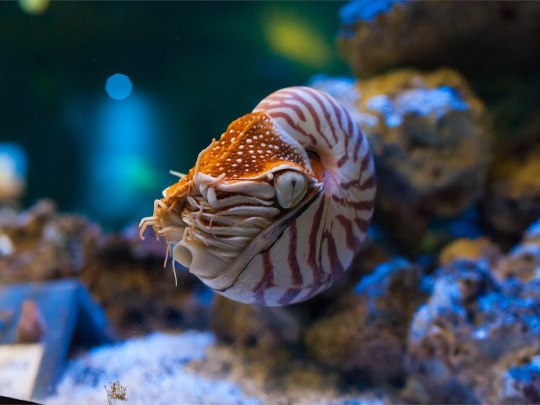
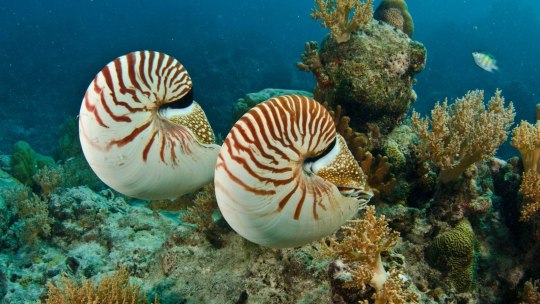
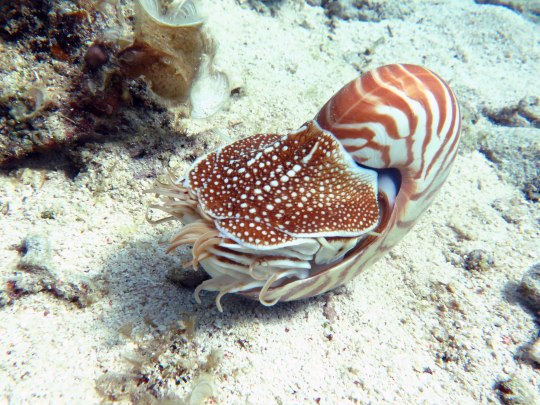
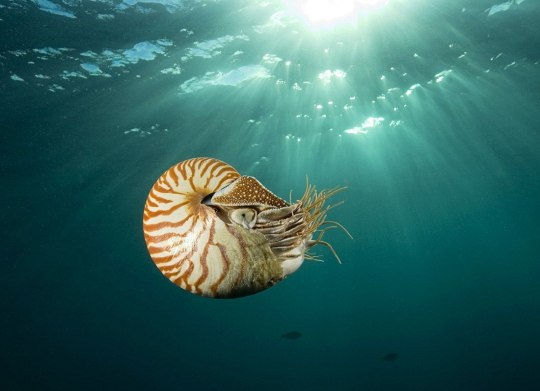

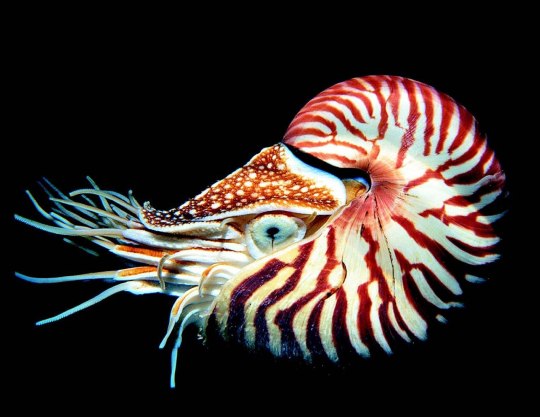

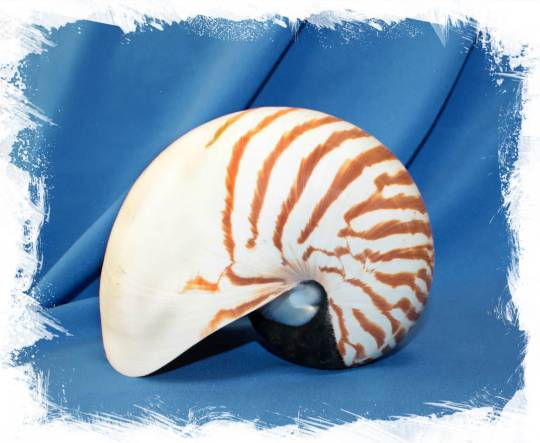
Наутилус (лат. Nautilus) — род головоногих моллюсков, которых относят к «живым ископаемым». Самый распространенный вид — Nautilus pompilius. Наутилусы относятся к единственному современному роду подкласса наутилоидей. Первые представители наутилоидей появились в кембрии, а его развитие пришлось на палеозой. Наутилиды почти вымерли на границе триаса и юры, но все же дожили до наших дней, в отличие от своих родственников аммонитов. Некоторые виды древних наутилусов достигали размера в 3,5 м. Представители самого крупного вида современных наутилусов достигают максимального размера в 25 см.
Спиральный «домик» моллюска состоит из 38 камер и «построен» по сложному математическому принципу (закон логарифмической прогрессии). Все камеры, кроме последней и самой большой, где размещается тело наутилуса с девятью десятками «ног», соединяются через отверстия между собой сифоном. Раковина наутилуса двухслойная: верхний (наружный) слой – фарфоровидный – действительно напоминает хрупкий фарфор, а внутренний, с перламутровым блеском – перламутровый. «Домик» наутилуса растет вместе с хозяином, который перемещается по мере роста раковины в камеру попросторней. Пустое жилище моллюска после его гибели можно встретить далеко от его места обитания – после гибели «хозяина» их раковины остаются на плаву и перемещаются по воле волн, ветров и течений.
Интересно, что двигается наутилус «в слепую», задом наперед, не видя и не представляя препятствий, которые могут оказаться на его пути.И еще одно удивительное качество этих древних обитателей Земли – у них потрясающая регенерация: буквально через несколько часов раны на их телах затягиваются, а в случае потери щупальца быстро отрастает новое.
Nautilus is a genus of cephalopods, which are classified as "living fossils". The most common species is Nautilus pompilius. Nautilus belong to the only modern genus of the Nautiloid subclass. The first representatives of the Nautiloids appeared in the Cambrian, and its development took place during the Paleozoic. The Nautilids almost died out on the border of the Triassic and Jurassic, but still survived to the present day, unlike their Ammonite relatives. Some species of ancient Nautilus reached a size of 3.5 m. Representatives of the largest species of modern nautilus reach a maximum size of 25 cm.
The spiral "house" of the mollusk consists of 38 chambers and is "built" according to a complex mathematical principle (the law of logarithmic progression). All chambers, except the last and largest, where the nautilus body with nine dozen "legs" is located, are connected through holes with a siphon. The nautilus shell is two–layered: the upper (outer) layer – porcelain–like - really resembles fragile porcelain, and the inner, with a mother-of-pearl luster - mother-of-pearl. The nautilus's "house" grows with its owner, who moves as the shell grows into a larger chamber. The empty dwelling of a mollusk after its death can be found far from its habitat – after the death of the "owner", their shells remain afloat and move at the will of waves, winds and currents.
Interestingly, the Nautilus moves "blindly", backwards, without seeing or imagining the obstacles that may be in its path.And another amazing quality of these ancient inhabitants of the Earth is that they have amazing regeneration: in just a few hours, the wounds on their bodies heal, and in case of loss of tentacles, a new one grows quickly.
Источник:://t.me/+t0G9OYaBjn9kNTBi, /sevaquarium.ru/nautilus/, /habr.com/ru/articles/369547/, //wallpapers.com/nautilus, poknok.art/6613-nautilus-molljusk.html, //wildfauna.ru/nautilus-pompilius, /www.artfile.ru/i.php?i=536090.
#fauna#video#animal video#marine life#marine biology#nature#aquatic animals#cephalopods#Nautilus#nautilus pompilius#living fossils#ocean#benthic#coral#plankton#beautiful#animal photography#nature aesthetic#видео#фауна#природнаякрасота#природа#океан#бентосны��#головоногие моллюски#Наутилус#живое ископаемое#коралл#планктон
187 notes
·
View notes
Text
If you asked me as a kid what my favorite animal was, there's a good chance I'd respond "chambered nautilus", though I probably would mispronounce it. I don't know if it's still my favorite but it's definitely up there in the pantheon of weird critters. For this Wet Beast Wednesday, I'll discuss my childhood favorite.
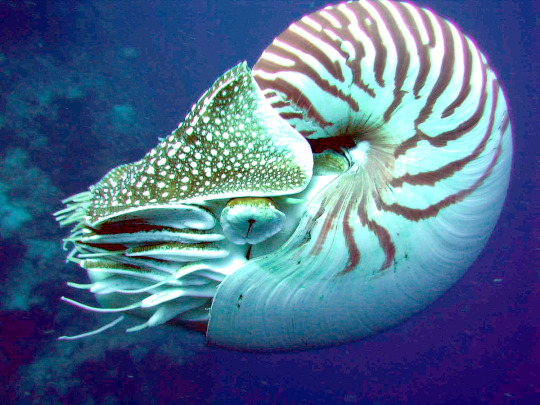
(image: a nautilus)
The nautilus is a cephalopod that lives in a curved shell and looks similar to (but is not closely related to) the extinct ammonites. There are 6 living species in two genera, but 90% of the time when someone is discussing nautiluses they are referring to the most well-known species: Nautilus pompilius or the chambered nautilus. Nautiloids are ancient, going back to at least the late triassic with their more primitive ancestors going back as far as the ordovician period, a time when only invertebrates and primitive plants occupied the land and true fish had not yet appeared. Because of their ancient history, nautiluses are sometimes considered living fossils. I have ranted before on how misleading the term "living fossil" is so I'll spare you that for now. Nautiloids are considered a sister group to the celoids, which contains all the squid, octopus, cuttlefish, and everything else we thinks of as cephalopods. Nautiluses should not be confused with paper nautiluses. Also called argonauts, paper nautiluses are a group of octopi that make an egg case which looks like a shell.
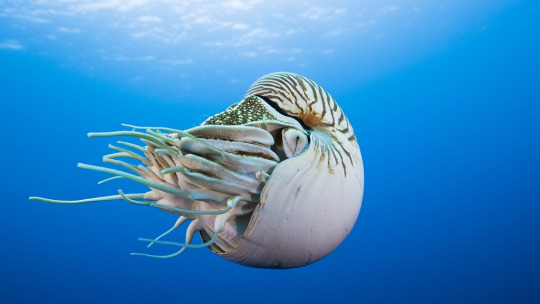
(image: a nautilus)
The most noticeable feature of a nautilus is its shell. The shell is smooth and finely curving, naturally growing in the shape of a logarithmic spiral (though not, as is commonly stated, a golden ratio spiral). The shell has a stripy outer layer and an inner layer coated with nacre. Internally, the shell is divided into camarae (chambers) separated from each other by walls called septa. Each septum has a small hole in it through which a strand of tissue called the siphuncle passes. Most of the nautilus's body is in the foremost and largest chamber. The shell grows new septa as the animal grows, with the nautilus's body moving to a new chamber as it becomes too large for previous ones. Juveniles are typically born with 4 septa, with adults having as many as 30. In addition to providing protection from predators, the shell is also key for regulating buoyancy. The septa can contain pressurized gas or water and the siphuncle regulates their contents by either adding or removing water to increase or decrease buoyancy. Because of its pressurized contents, the shell can only withstand pressure at depths up to 800 M (2,400 ft) before imploding. Oddly enough, nautiluses can be safely brought up from deep waters where most animals would be killed by the pressure changes. To move, the nautilus pulls water into the first chamber of the shell using its hyponome (siphon) and shoots it back out. The chambered nautilus is the largest species, with a maximum shell diameter of 25 cm (10 in), though most get no larger than 20 cm (8 in).
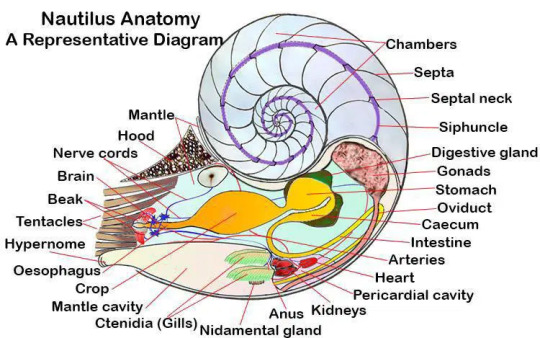
(image: a diagram of nautilus anatomy. source)
Where celoid cephalopods have tentacles, nautiluses instead have numerous cirri. Unlike tentacles, cirri are less muscular, are not elastic, and have no suckers. They are used to grab objects using their ridged surfaces and can hold in so hard that trying to take an object away from a nautilus can rip off its cirri, which will remain firmly attached. In addition, the nautilus has modified cirri that serve as olfactory receptors and a pair that serve to open and close the shell when the nautilus needs to retract into it or emerge. Nestled within the cirri is the beak, which is used to consume the nautilus's primary prey of invertebrates, though they have also been seen scavenging fish. Their eyes are less developed than most cephalopods, lacking a lens and consisting of a small pinhole that only allows the nautilus to see simple imagery. Their brains are differently structured than most cephalopods and studies have found them to have considerably shorter long-term memories.
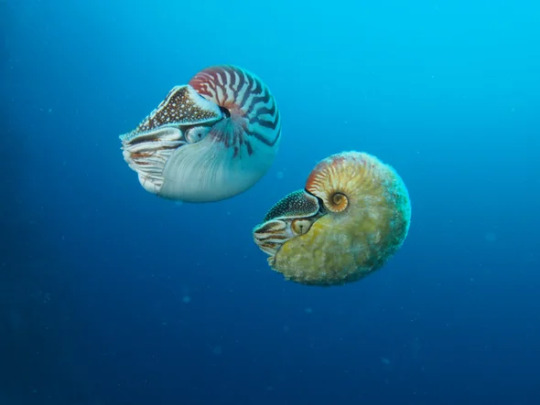
(image: a chambered nautilus (upper left) next to a rare Allonautilus scrobiculatus. source)
Cephalopod reproduction is quite different than that of other cephalopods. While most cephalopods are short-lived and semelparous (reproducing only once), nautiluses can live over 20 years and reproduce multiple times (iteroparity). They do not reach sexual maturity until around 15 years old, with females laying eggs once per year. Eggs are attached to rocks and take 8 to 12 months to hatch. Males have a structure called the spadix composed of 4 fused cirri that they use to transfer sperm to females. Females lose their gonads after laying their eggs and will regenerate them for the next year's mating season. Interestingly, male nautiluses seem to vastly outnumber the females. EDIT: @bri-the-nautilus in the replies found an alternate explanation for the disparity in male and female numbers you should check out. TLDR; the females are asocial.
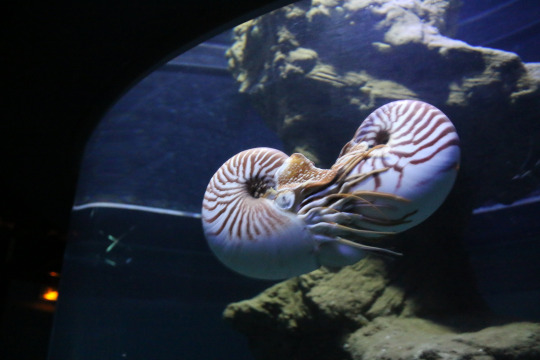
(image: nautiluses mating)
Nautiluses are found in the Indo-Pacific reagion of the ocean and can be found on the steep slopes of coral reefs. They prefer to inhabit waters several hundred meters down. It was once believed that they would rise to shallow waters at night to feed, lay eggs, and mate, but their vertical migration behavior has since been shown to be more complex than that. They have noon been fished by humans for their shells, which have become popular subjects in art and can be made into a number of decorative pieces. The nacre of the shell can be polished into osmeña pearl, which can be quite valuable. Demand for the shells combined with the late sexual maturity and low fecundity is threatening all the species. As of 2016, nautiluses have been added to the CITES Appendix II, making them protected by limiting international trade of their shells. Despite this, they are still threatened and require further protection

(image: a carved and painted nautilus shell from the Poldi Pezzoli Museum, Milan)
#wet beast wednesday#nautilus#chambered nautilus#cephalopod#marine biology#zoology#biology#ecology#animal facts
1K notes
·
View notes
Text
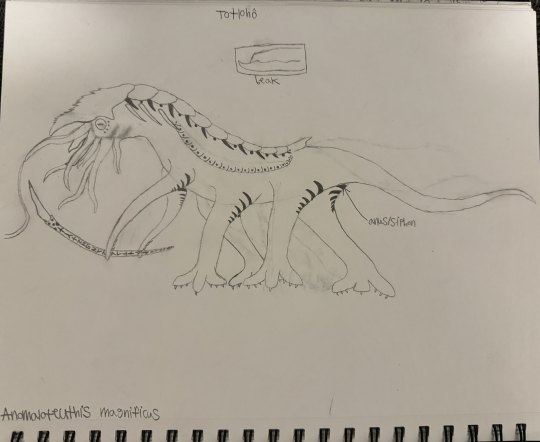
Totlohô
Kingdom: Animalia
Phylum: Mollusca
Class: Cephalopoda
Subclass: Nautiloidea
Superorder: Alysidaceratoidea
Order: Paratetrapoda
Superfamily: Cotylopodoidea
Family: Cotylopodidae
Subfamily: Anomaloteuthiinae
Genus: Anomaloteuthis
Species: A. magnificus (”magnificent unusual squid”)
Ancestral species: possibly Plectronoceras cambria
Temporal range: Early Jurassic (Toarcian) to Early Cretaceous (Hauterivian) (180 - 130 mya)
Information:
While humans have long seen themselves as the first and only sapient species to inhabit their planet, in all truth, there existed another in Xenogaea several hundreds of millions of years ago, one whose legacy can still be felt throughout the region untold eons later in their bizarre ruins and artifacts: the Totlohô-tu-Tẋusko/Tẋusko-tu-Totlohô (IPA: /to̞t͡ɬo̞hɔ tu t͡ʃusko̞/ OR /t͡ʃusko̞ tu to̞t͡ɬo̞hɔ/, meaning "ancestor of (the) architect"), better known as simply the Totlohô (/to̞t͡ɬo̞hɔ/, simply meaning "architect").
As soft tissues of this species have only rarely been preserved, and hard tissues consist only of armor plating and beaks, their size and general appearance alone must be inferred purely based on known proportions from living relatives, other members of the aberrant nautiloid clade Alysidaceratoidea, known more colloquially as the shrikehounds. The most reliable size estimate places them at around 12 feet long, 6-7 feet tall, and weighing close to 600 lbs. The appearance of these creatures, based on ancient stone murals, would seem to suggest that they were centaur-like in build, sporting six main limbs along with a menagerie of smaller tentacles around the face, which housed a long, narrow beak with a noticeable underbite. The exact coloration of this species isn’t known, though as murals exist which depict them, it can be inferred that they might have had a similar coloration pattern to living nautili, with a creamy-colored body and eyes with an earthy red shell and head piece.
Living shrikehound species are not particularly vocal, with only the paratetrapods having an analogue to proper vocal cords. This species was presumably vocal in some capacity, though the exact vocalizations cannot be deduced. It has been suggested that like their living relatives, they might have been able to produce clicks, grunts, warbles, rumbles, belches, screeches, and shrieks. It has been suggested, however, that they may have convergently evolved chromatophores like some of their living relatives and may have had a primarily visual language instead, one which has not, as of yet, been decoded.
Much of these organism's general biology is not known conclusively. Most evidence points to a carnivorous diet, consisting mainly of small dinosaurs/paravians, but also other terrestrial nautiloids, small mammals, and a bizarre group of terrestrial acanthodians known as coelospondyls. Though the exact place where they first evolved has yet to be conclusively found, fossilized beaks first appear in the Matansitra Formation in the southwest of the Isle of Perils, though later formations across the entire archipelago show that almost every habitable landmass sported a population of these creatures at one point. Dubious material from areas outside the archipelago, including what is now China and Australia, suggests they may have eventually left the archipelago at some point as well. At their peak during the Kimmeridgian age of the Late Jurassic epoch roughly 150 millions years ago, their population size was likely upwards of 40 million. Very little (if anything) can be inferred about their reproductive biology, though murals would seem to suggest that courtship and copulation was a very long, drawn-out process, treated almost as an art form unto itself. From their closest relatives, it can be inferred that the males, using a modified tentacle, deposited sperm into a small groove on the female’s underside, where it could be absorbed and used to fertilize the eggs. Their clutch size is believed to have been anomalously small compared to other species in their clade, possibly no more than 10 eggs at a time. The young appear to have matured at a similar rate to human young, if not slightly faster. Sexual dimorphism does not appear to be a prominent trait within their species.
Not much can be inferred about the behavior of this species from what remnants have been found, though it can be inferred that they were likely highly social creatures with complex social structures. They appear to have engaged in agrarianism and the farming of other animals in their later stages of societal development, as evidenced by a high correlation in dump beak remains found near dump sites for animal bones and shell, and even built cities. Murals would seem to suggest Totlohô society was ruled by a class of elders, the oldest respective members of their society, while the youngest members formed the work force. Song and dance appear to have been ways to bond with one another, and spirituality played a large part in their society’s function. Warfare appears to have been an isolated phenomenon in their society and frequently on a much smaller scale than as seen in humanity, though there exists some evidence of widespread warfare in the later years of existence. Even in their later stages, when they evidently had significantly advanced technology (or, as the more conspiracy-minded would suggest, magic of some kind), the Totlohô still preferred to build their homes out of stone.
During the later stages of their existence, the Totlohô appear to have dabbled in what appears to be highly-advanced technology or potentially even magic of some kind, as evidenced by massive, seemingly Totlhômade, carved, levitating stones covered in glyphs. In a place known as the Square Chasm (picture below, artwork by Dipfruit), a reportedly supernatural space some weary jungle travelers have stumbled upon near a triple-forked river, one of these stones appears to have formed a perfectly square-shaped pocket dimension around itself, where gravity itself appears to bend to the stone’s whim.

Fossilized beaks and hard shells are really the only physical parts of these creatures to have been preserved, and they are the only indication of their existence outside of aforementioned ruins and murals. Their written languages have yet to be decoded, and there are believed to have been several thousand at a given time. What exactly led to their extinction has yet to be conclusively revealed, though murals seem to suggest that, from their perspective, supernatural forces may have been at play, with recurrent imagery of what appears to be demonic figures showing up across several murals. Another recurrent image in these murals is a white bird-like creature with horns, which some have suggested may be related to the mythical white bird seen in Xenogaean mythology, which was said to herald the apocalypse. While some have suggested that these murals may have been painted by one of the last Totlohô, who had simply gone insane from isolation and began painting their hallucinations, others suggest that there might be a grain of truth in these murals, perhaps a war of apocalyptic scale which engulfed the entire species, the demagogues fueling it being portrayed as demonic figures. What this doesn’t explain, however, are the high number of artifacts which appear to be made from an unknown metallic substance, one which is highly durable and in near-pristine condition hundreds of millions of years later. This substance, referred to colloquially as “anomalous tungsten”, is paradoxically lightweight yet durable with a high melting point, seemingly higher than almost any other known metal or metalloid. As this metal has not been found anywhere on Earth or even in any known compounds on Earth or another planet, this begs the question of how and where the Totlohô obtained this substance, leading to a wide menagerie of conspiracy theories, with everything from extraterrestrials to divine beings being suggested as the source from which they obtained this material. Whatever the case, those who have studied the artifacts have claimed to have had vivid dreams where they spoke to the Totlohô shortly after contact. Perhaps this is just a form of confabulation or merely even group hysteria, but nonetheless, it would appear that even long after the Totlohô have left this world, their legacy still manages to touch the human spirit. Finally, they appear to have domesticated a species of coelospondyl, Platycephale aridus, the so-called “flat-faced coelospondyl” (1st picture below, artwork by me), and another species of shrikehound, which is currently unnamed (2nd picture below, artwork by me). These appear to have been utilized as livestock animals.


#novella#speculative evolution#fantasy#scifi#scififantasy#speculative biology#speculative fiction#speculative zoology#worldbuilding#creature art#sophont#sci fi creature#creature design#fantasy creature#creative writing#creature#scifi worldbuilding#fantasy worldbuilding#nautiloid#nautilus#cephalopod#mollusk#cephalopods
18 notes
·
View notes
Text
Living in the Paleozoic Era 🌿🦕🌏
Welcome to a journey back in time to the Paleozoic Era, a period of Earth's history that spans from about 541 million to 252 million years ago. It's a time of ancient landscapes, bizarre creatures, and dramatic geological changes. Let's dive into what life was like during this fascinating era!
🌍 Ancient Supercontinents: During the Paleozoic Era, Earth looked quite different from what we know today. The landmasses were joined together in the supercontinent Pangaea, surrounded by a vast Panthalassa Ocean.
🌋 Volcanic Activity: Volcanoes were a common sight, and they released massive amounts of greenhouse gases, creating a warm, tropical climate. Sea levels were much higher, with shallow seas covering large portions of the continents.
🌿 The Dawn of Life: Life was thriving, but it was vastly different from the species we see today. The first land plants appeared, bringing greenery to the barren landscapes. These early plants laid the foundation for terrestrial ecosystems.
🐚 Marine Wonders: The oceans were teeming with life. Ancient creatures like trilobites, nautiloids, and jawless fish ruled the seas. Corals began building reefs, while the first fish with jaws emerged.
🦗 Invasion of Land: One of the most significant events of the Paleozoic was the colonization of land. Arthropods, like millipedes and scorpions, were among the first to venture onto the continents. They were soon followed by amphibians.
🌅 Mass Extinctions: The era was marked by multiple mass extinctions, including the Ordovician-Silurian and Permian-Triassic extinctions. These events shaped the course of life on Earth and paved the way for new species to evolve.
🦕 The Age of Reptiles: By the late Paleozoic, reptiles had emerged, including the iconic sail-backed Dimetrodon. These reptiles were the ancestors of the dinosaurs that would dominate the next era.
🌄 The End of an Era: The Paleozoic Era came to a close with the Permian-Triassic extinction, the most devastating in Earth's history. It wiped out nearly 95% of marine species and marked the end of many Paleozoic life forms.
Today, we marvel at the remnants of the Paleozoic Era, from the fossils of trilobites to the geological formations that tell the story of this ancient world. Studying this era helps us understand the evolution of life on Earth and the forces that have shaped our planet.
#PaleozoicEra#AncientEarth#LifeOnLand#MassExtinctions#PrehistoricCreatures#GeologicalHistory#FossilHunting#EvolutionaryTimeline#DawnOfLife#ReptilianWorld#Paleontology#AncientLandscapes#GeologicalWonders#EarthHistory#SailBackedReptiles#Pangaea#PrehistoricPlants#AncientOceans#TriassicEra#PermianExtinction#Trilobites#Amphibians#VolcanicActivity#PanthalassaOcean#Arthropods#FossilRecord#PrehistoricClimate
0 notes
Photo

Half a billion years in and still going strong: The chambered nautilus!
Shelled cephalopods once ruled ancient oceans, with thousands of species of terrific and tentacular beasties living in ornate calcified homes cruising the sea before most fishes were around. Mass extinctions due to changing ocean chemistry doomed many, including the famed ammonites, to fossil-dom, while nautiloids survived thanks to their low and slow lifestyle in the deep. Congrats for being an evolutionary success story so far, nautiluses! You deserve to be shellebrated this Cephalopod Awareness Days Nautilus Night!
#monterey bay aquarium#international cephalopod awareness days#nautilus night#shell yeah!#get those 90 tentacles in the air and wave them around like you just don't care!
725 notes
·
View notes
Text
i love knowing which ancient creatures lived where i do... like our state fossil is the trilobite!! love those guys!!! and that bigass nautiloid fossil in the cave near me... ough
2 notes
·
View notes
Text

i had to do something with this info
And the humans themselves had fossils to suggest cephalopods are some of the oldest animals on earth --- fossils, of nautiloids and ammonoid shells, and even belemnites, an ancient squid with a bullet-shaped rostrum (guard) that fossilized often---
1 note
·
View note
Photo


Doodledex - #138 Omanyte
...Ok, I know you were all clamoring to make Twitch Plays Pokemon jokes here more than with Pidgeot, so go ahead. This is the last time, though!
Anyways, it’s pretty fitting that the first Fossil Pokemon in the dex is an ammonite, since they were once really common in the ancient seas, starting from the Devonian! In fact, these molluscs managed to survive the Permian extinction event (with only a few species surviving but quickly multiplying again), something that even wiped out the just as common trilobites! Unfortunately, they failed to survive the Cretaceous extinction. (The surviving nautiloids, on the other hand, are not ammonites, and are even more ancient, going all the way back to the Cambrian!)
#pokemon#doodledex#omanyte#as for our good buddy omanyte here#its method of swimming is mostly in line with how the nautilus swims#(excluding its siphon)#but it isn't an active predator or even a scavenger!#it filter feeds instead which is something ammonites may have actually done!#(these interesting extinct cephalopod facts brought to you by wikipedia!)
11 notes
·
View notes
Photo

Orthoceras vagans Fossil Orthocone | Ordovician Ashgill Series Rhiwlas Bala Wales UK | Genuine Specimen with COA
Enhance your fossil collection with this authentic Orthoceras vagans orthocone fossil, originating from the Ashgill Series of the Late Ordovician period, found in Rhiwlas, near Bala, Gwynedd, Wales, UK. This striking straight-shelled cephalopod is a genuine remnant of ancient marine ecosystems that existed over 445 million years ago.
Fossil Type: Orthocone Cephalopod
Species: Orthoceras vagans
Geological Period: Ordovician (~485 to 443 million years ago)
Geological Series: Ashgill (Late Ordovician)
Location: Rhiwlas, Bala, Gwynedd, Wales, UK
Scale Rule: Squares/Cube = 1cm (Please refer to the photo for full sizing details)
Specimen: The photo shows the exact specimen you will receive
Authenticity: All of our fossils are 100% genuine specimens and come with a Certificate of Authenticity
Geological and Paleontological Information
Orthoceras vagans was a type of extinct nautiloid cephalopod belonging to a group of straight-shelled marine molluscs that thrived in the Paleozoic oceans. Fossils from the Ashgill Series of the Ordovician represent some of the last cephalopod species before the major end-Ordovician extinction event.
Phylum: Mollusca
Class: Cephalopoda
Order: Orthocerida
Family: Orthoceratidae
Superfamily: Orthocerataceae
Geological Stage: Ashgill (approximately 449 to 443 million years ago)
Depositional Environment: Deeper marine shelf environment with fine-grained sediments like shales and limestones typical of the Welsh Basin during the Late Ordovician
Morphological Features: Long, straight shell (orthocone) with multiple internal chambers (phragmocone); transverse septa separate the chambers; central or subcentral siphuncle used for buoyancy regulation; external ornamentation may include fine growth lines and annulations
Notable: Orthoceras vagans and other orthocerids from the Bala region are crucial for understanding cephalopod evolution and paleoecology in the pre-extinction Ordovician marine environment
Biozone: Likely corresponds to the upper Ordovician graptolite or brachiopod biozones of the Ashgill Series, though exact zonation is site-dependent
Identifier: The species vagans has been recognized in European Ordovician fossil records and is frequently used in stratigraphic studies
Why This Fossil Is Special
This fossil provides a window into the Late Ordovician seas of ancient Wales and offers both scientific and aesthetic appeal. Its preservation in a region of high stratigraphic importance makes it valuable for collectors, educators, and geologists alike.
Why Buy From Us?
100% genuine fossil with Certificate of Authenticity
The item shown in the photos is exactly what you will receive
Ethically sourced from established UK fossil localities
Great for teaching, scientific research, collecting, or display
Own a rare and historically significant piece of Earth's ancient oceans with this Orthoceras vagans fossil orthocone from the Ashgill Series of Rhiwlas, Bala, Wales — an enduring relic from over 445 million years ago.
#Orthoceras vagans#Orthoceras fossil#fossil orthocone#Ordovician fossil#Ashgill fossil#Rhiwlas fossil#Bala fossil#Wales fossil#UK fossil#cephalopod fossil#straight-shelled nautiloid#certified fossil#genuine fossil#fossil with certificate#Paleozoic fossil#marine fossil#ancient sea life#natural history specimen
0 notes
Photo

Scandinavia Wolf Orthoceras Fossil Pendant w/ silver chain necklace Scandinavia Wolf's necklaces are handmade in Squamish, B.C. Canada. 22" sterling silver curb chain with lobster clasp Orthoceras Fossil with silver loop pendant, each one is unique Orthoceras, is a genus of extinct nautiloid cephalopod. By meditating with the fossil’s energy, one may feel a connection to that ancient Earth and all the knowledge that it contains. Orthoceras will activate our root chakra by grounding us down to earth with ancient energy. #yaletown #shopvancouver#shopocal#fossil # (at Global Atomic Designs Inc.) https://www.instagram.com/p/CRW7G5lMPyZ/?utm_medium=tumblr
0 notes
Photo

FOSSILS Orthoceras, also known as Orthoceratites, is a genus of extinct nautiloid cephalopod. Its name is derived from the words “straight horn”, referring to it’s long, conical shell. These creatures roamed the seas during the Ordovician Period (485 million - 443 million years ago). The preserved shell is all that remains of this ancestor of our modern-day squid. The soft body lived in the last open-ended segment at the large end of the conical shell. Like the ammonite it is a cephalopod. Fossils are believed to increase life span, reduce toxins, anxiety, stress, balance the emotions, make one more confident. Containing supernatural and physical healing powers. They promote a sense of pride and success in business. Fossils are believed to increase life span, reduce toxins, anxiety, stress, balance the emotions, make one more confident. Containing supernatural and physical healing powers. #Orothoceras #Fossils #ManchacSwamp also known as #GhostSwamp Petrified Swamp Mud #PetrifiedSwampMud Petrified Swamp Gas #PetrifiedSwampGas Petrified Wood: Petrified wood has a nurturing & healing energy that makes it a wonderful stone for root chakra healing. Imbalances in the root chakra can lead to feeling spaced out, disconnected, and feeling insecure around safety and basic needs. Petrified wood provides a sense of being calm and centered while helping you to resolve the underlying imbalance. Healing with Petrified Wood may assist you to read the Akashic Records, and are helpful to use for past life or ancestral healing, assisting you to connect to the past through following the rings in the stone. Also called Fossilized Wood, they have a strong grounding energy which may assist you to make a good connection via the base and earth chakra. Petrified Wood is used for pain relief, particularly in the spine and hips. Petrified Wood is also said to be helpful in past-life recall or past-life regression work. Which would make sense as it holds the ancient spirits within and they can provide guidance in past-life workings. #PetrifiedWood #Rootwork #Conjure #Hoodoo #Voodoo #Obeah #RespectTheVoodoo #Ancestors #TheAtlasOfCURSEDPlaces #AtlasOfCURSEDPlace (at House of the Divine Prince) https://www.instagram.com/p/CJMDNY0j8F6/?igshid=15gcp8dm4qb03
#orothoceras#fossils#manchacswamp#ghostswamp#petrifiedswampmud#petrifiedswampgas#petrifiedwood#rootwork#conjure#hoodoo#voodoo#obeah#respectthevoodoo#ancestors#theatlasofcursedplaces#atlasofcursedplace
0 notes
Photo

Dawsonoceras annulatum Orthoceras Fossil Orthocone | Wenlockian Silurian Ledbury UK | Genuine Specimen with COA
Own a remarkable piece of British geological heritage with this genuine Dawsonoceras annulatum orthocone fossil from the Wenlockian stage of the Silurian period, discovered near Ledbury, Herefordshire, UK. This straight-shelled cephalopod fossil offers insight into marine life that thrived over 425 million years ago in the shallow seas of the ancient Welsh Borderlands.
Fossil Type: Orthocone Cephalopod
Species: Dawsonoceras annulatum
Geological Period: Silurian (~443 to 419 million years ago)
Geological Stage: Wenlockian (Wenlock Epoch, ~433 to 427 million years ago)
Location: Ledbury, Herefordshire, United Kingdom
Scale Rule: Squares/Cube = 1cm (Refer to photo for full sizing)
Specimen: The photo shows the actual specimen you will receive
Authenticity: All of our fossils are 100% genuine specimens and come with a Certificate of Authenticity
Geological and Paleontological Information
Dawsonoceras annulatum is a genus of straight-shelled nautiloid cephalopods found in Silurian marine strata. This genus is distinguished by its distinctive annulate (ringed) ornamentation along the length of its orthoconic shell. Specimens from the Ledbury area are preserved in marine sedimentary rocks deposited in a warm, shallow sea during the Wenlock Epoch.
Phylum: Mollusca
Class: Cephalopoda
Order: Orthocerida
Family: Dawsonoceratidae
Superfamily: Orthocerataceae
Depositional Environment: Shallow marine platform with low-energy carbonate and calcareous mudstone deposition
Morphological Features: Long, straight (orthoconic) shell with regularly spaced transverse ridges (annulations); internally chambered phragmocone with a central or subcentral siphuncle used for buoyancy control
Notable: Dawsonoceras annulatum is a well-documented nautiloid species from the Wenlockian of Britain and contributes significantly to our understanding of Silurian marine ecosystems
Biozone: Likely falls within graptolite or brachiopod-based Wenlock biozones; specific assignment requires precise stratigraphic positioning
Identifier: Originally described in 19th-century paleontological literature; well-represented in British Silurian collections
Why This Fossil Is Special
This orthocone fossil from Ledbury is not only aesthetically striking with its annulated shell but also holds scientific importance. It comes from the Wenlockian strata of the Welsh Borderland, a globally recognized reference area for Silurian stratigraphy.
Why Buy From Us?
100% genuine fossil with Certificate of Authenticity
What you see is what you get—specimen in photo is the one you will receive
Ethically sourced from historically significant UK geological formations
Excellent for collectors, educators, and fossil enthusiasts
Bring home a captivating relic from Earth’s ancient oceans—this Dawsonoceras annulatum fossil from the Wenlockian Silurian seas of Ledbury, UK is a true collector’s treasure from over 425 million years ago.
#Dawsonoceras annulatum#Orthoceras fossil#fossil orthocone#cephalopod fossil#Silurian fossil#Wenlockian fossil#Ledbury fossil#UK fossil#straight-shelled nautiloid#certified fossil#genuine fossil#fossil with certificate#Paleozoic fossil#natural history#marine fossil#fossil collection#ancient sea life
0 notes
Photo

Orthoceras Fossil Orthocone | Valentian Stage Silurian Acton Scott Beds Shropshire UK | Genuine Specimen with COA
Enhance your fossil collection with a genuine Orthoceras orthocone fossil, discovered in the Acton Scott Beds of Shropshire, UK, dating back to the Valentian stage of the Middle Silurian period. This beautifully preserved fossil represents an ancient straight-shelled nautiloid cephalopod that once roamed the warm Silurian seas covering much of Britain.
Fossil Type: Orthocone Cephalopod
Genus: Orthoceras (general attribution; UK Silurian orthocones often not assigned to species level)
Geological Period: Silurian (~443 to 419 million years ago)
Geological Stage: Valentian (part of the Homerian-Wenlockian, Middle Silurian)
Formation: Acton Scott Beds
Location: Shropshire, England, UK
Scale Rule: Squares/Cube = 1cm (See photograph for full sizing)
Specimen: Actual fossil pictured is the exact specimen you will receive
Authenticity: All of our fossils are 100% genuine specimens and come with a Certificate of Authenticity
Geological and Paleontological Context
Orthoceras is a genus of extinct nautiloid cephalopods characterized by long, straight conical shells divided into multiple internal chambers. These fossils are found in marine limestones and mudstones, and the Acton Scott Beds are particularly rich in such marine deposits from the Silurian Wenlock Epoch.
Phylum: Mollusca
Class: Cephalopoda
Order: Orthocerida
Family: Orthoceratidae
Superfamily: Orthocerataceae
Depositional Environment: Shallow marine shelf, low-energy carbonate setting typical of mid-Silurian seas in Britain
Morphological Features: Long, straight orthoconic shell with a series of septa dividing the internal phragmocone chambers; siphuncle used for buoyancy control; external growth lines may be visible
Notable: Fossils from the Acton Scott Beds contribute to the understanding of mid-Silurian marine biodiversity and stratigraphy in the Welsh Borderland region
Biozone: Stratigraphically lies within the Valentian regional stage, correlated with upper Wenlock global stages (e.g. Ludfordian or Homerian biozones, depending on detailed layer)
Identifier: Early Orthoceras species were first described in the 18th century, though UK examples from Silurian strata are often generically attributed due to limited diagnostic features on fragmentary material
Why This Fossil Is Special
This Orthoceras specimen provides a tangible link to Earth’s Paleozoic marine life, and originates from a locality of significant geological interest. Its preservation within the Acton Scott Beds adds to its value as a collector's item, teaching tool, or display piece.
Why Buy From Us?
100% genuine fossil with Certificate of Authenticity
What you see is what you get: exact specimen pictured
Ethically and professionally sourced from UK Silurian formations
Great for educational, scientific, or decorative purposes
Add this authentic Orthoceras orthocone fossil from the Valentian-aged Acton Scott Beds of Shropshire to your collection and own a piece of Britain’s ancient Silurian seas from over 425 million years ago.
#Orthoceras fossil#fossil orthocone#Silurian fossil#Valentian stage fossil#Acton Scott Beds fossil#Shropshire fossil#UK fossil#Middle Silurian fossil#nautiloid fossil#cephalopod fossil#certified fossil#genuine fossil#fossil with certificate#Paleozoic fossil#marine fossil#natural history fossil#fossil collection#ancient sea life
0 notes
Photo

Orthoceras Fossil Orthocone | Silurian Wenlock Limestone UK | Wrens Nest Dudley | Genuine Specimen with COA
Own a genuine piece of Britain’s ancient marine heritage with this authentic Orthoceras fossil orthocone, discovered in the world-famous Wrens Nest site, part of the Wenlock Limestone Formation from the Wenlockian stage of the Silurian period. This fossil represents an extinct nautiloid cephalopod that once roamed the tropical seas covering the West Midlands over 420 million years ago.
Fossil Type: Orthocone Cephalopod
Genus: Orthoceras (in a broad sense; UK examples may await further taxonomic clarification)
Geological Period: Silurian (~443 to 419 million years ago)
Geological Stage: Wenlockian (specifically Wenlock Epoch, ~433 to 427 million years ago)
Formation: Wenlock Limestone Formation
Location: Wrens Nest, Dudley, West Midlands, UK
Scale Rule: Squares/Cube = 1cm (See photo for full sizing)
Specimen: The actual item shown is the specimen you will receive
Authenticity: All of our fossils are 100% genuine specimens and come with a Certificate of Authenticity
Geological and Paleontological Information
Orthoceras is an extinct genus of straight-shelled nautiloid cephalopods, commonly found in Silurian marine limestones. Wrens Nest is a Site of Special Scientific Interest (SSSI), renowned for its rich and exceptionally preserved Silurian fossil fauna, especially trilobites, brachiopods, corals, and cephalopods like this specimen.
Phylum: Mollusca
Class: Cephalopoda
Order: Orthocerida
Family: Orthoceratidae
Superfamily: Orthocerataceae
Depositional Environment: Shallow warm marine shelf; limestone deposition under low-energy conditions conducive to fossil preservation
Morphological Features: Long, conical shell (orthocone) composed of multiple internal chambers (phragmocone) separated by curved septa; central or subcentral siphuncle used for buoyancy regulation; often displays subtle growth lines or ribbing on external shell surface
Notable: Wrens Nest is one of the most important Silurian fossil sites in the world. Cephalopods like Orthoceras provide key insights into early marine ecosystems and cephalopod evolution
Biozone: Likely correlated with graptolite or brachiopod biozones within the Wenlock Limestone, though exact placement requires detailed stratigraphy
Identifier: Early forms of Orthoceras were formally named in the 18th century; UK examples from Dudley may not always be classified to species level without further preparation
Why This Fossil is Special
This fossil is more than a geological curiosity—it’s part of a site that has contributed greatly to the development of geological science. Wrens Nest was instrumental in the early study of stratigraphy and paleontology. The well-preserved phragmocone and historical provenance make this piece ideal for collectors and educators alike.
Why Buy From Us?
100% genuine fossil with Certificate of Authenticity
Exact specimen in photo is what you will receive
Carefully selected from scientifically significant UK sites
Ideal for display, teaching, or private collections
Bring home a remarkable relic from the ancient Silurian seas of Britain with this Orthoceras fossil orthocone from Wrens Nest, Dudley — a stunning addition to any fossil collection or natural history display.
#Orthoceras fossil#fossil orthocone#Wrens Nest fossil#Dudley fossil#Silurian fossil#Wenlock Limestone fossil#UK fossil#Orthocerid fossil#Wenlockian fossil#marine fossil#nautiloid fossil#cephalopod fossil#certified fossil#fossil with certificate#natural history fossil#fossil collection#ancient sea life#Paleozoic fossil#Silurian cephalopod
0 notes